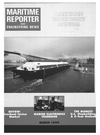
Page 39: of Maritime Reporter Magazine (March 1994)
Read this page in Pdf, Flash or Html5 edition of March 1994 Maritime Reporter Magazine
March, 1994 41
AWO: 50 Years Of Excellence
This year, as AWO and its mem- bers celebrate the association's 50th anniversary, we are reminded that the last half-century of challenge, progress, and victory demonstrate
AWO's enduring commitment to ser- vice to the barge and towing indus- try. Here are a few of AWO's his- torical highlights: • May 1944: The American
Waterways Operators (AWO) orga- nizes in Washington, D.C., charged with representing the inland barge and towing industry. The associa- tion is incorporated in Delaware on
May 22, 1944. On May 26, AWO holds its first meeting in St. Louis.
Throughout 1944, regional offices in New Orleans, Pittsburgh, and
Chicago are established. • July 1, 1950: The New York-
North Atlantic area is formally es- tablished, along with the Atlantic
Region (New York City) office, un- der an arrangement with the New
York Towboat Exchange and the
Harbor Carriers Association. • September 1955: The Na- tional Waterways Conference orga- nizes under the leadership of AWO to combat the threat of tolls and user charges on the nation's inland waterways. • June 1958: AWO organizes a
Boating Safety Committee with the purpose of achieving a better un- derstanding between operators of commercial vessels and users of pleasure craft to assure more har- monious and safe use of the water- ways. The Boating Safety Commit- tee quickly expands into the Na- tional Safe Boating Association in 1959 • February 1969: AWO's Board of Directors votes to amend theA WO
Constitution and Bylaws to include representation of the coastal sector as well as the inland sector. • February 1976: AWO opens its Midcontinent office in St. Louis to enhance service to members in the Ohio Valley and Midwest re- gions. The office is closed from 1983 to 1990 during the inland industry depression, but is reopened in 1991 in the midst of an ambitious mem- bership campaign in those regions. • February 1976: AWO's Ship- building and Ship Repair Commit- tee reorganizes as the American
Waterways Shipyard Committee, addressing exclusively the needs and concerns of AWO members' sec- ond-tier shipyards. • December 1978: The Ameri- can Waterways Shipyard Commit- tee becomes the American Water- ways Shipyard Conference (AWSC).
AWSC emerges as an integral part of AWO, representing the interests of small- and medium-sized ship- yards. • Fall 1979: AWO leaders ap- proach the House Coast Guard and
Navigation Subcommittee to seek assistance in enhancing communi- cation between the industry and the Coast Guard. Subsequent meet- ings result in the drafting and pas- sage of a bill by the Subcommittee calling for the establishment of the
Towing Safety Advisory Committee (TSAC). TSAC becomes an advi- sory group to the Secretary of Trans- portation on October 6, 1980. • March 1983: AWO unites with its sister organization, the Water
Transport Association, to form the
Water Transport Conference, to ad- dress the issues of rail-water compe- tition. • July 1988: The midwest drought spurs AWO to organize lead- ers from industry, the Corps of Engi- neers, and Coast Guard to form the
River Industry Executive Task Force (RIETF) to manage the drought's effects on navigation on the nation's inland river system. The RIETF is resurrected in 1993 with the Great
Flood in the midwest. • March 1989: AWO launches its Lifelines boating safety program, borrowing on its early and enduring commitment to marine safety. • January 1 991: The Towboat and Harbor Carriers Association merges with AWO, bringing 20 new members to the association and cre- ating a single, stronger voice for the industry along the Atlantic Coast. • April 1 993: AWO's Task Force on Mission, Structure and Finance recommends a plan to, among other things, create four committees and a Common Issues Council to better target AWO on the needs of the industry's operational sectors. The new committees, Inland Dry, In- land Liquid, Coastal, and Harbor
Services, give members forums in which they can focus on issues spe- cific to their particular operation.
Compiled by Eve Ann Holloway,
American Waterways Operators
When You I
Maintenance
You Need I
You Need
Need It Fast
Your Best Choice For All Types Of Work On Steel,
Aluminum and Composite Vessels.
Intermarine's extensive maintenance and repair facility provides year 'round service from major damage repair to unlimited topside and overhaul capabilities including engine and propulsion systems.
Our staff of engineers and technicians are skilled and experienced, our location ideal.
Call us for your next maintenance or repair job, 1-912-234-6579.
Circle 307 on Reader Service Card
P.O. Box 3045, 301 North Lathrop Avenue
Savannah, Georgia 31402-3045,
United States of America
Tel: 912-234-6579 Fax: 912-234-0717

 38
38

 40
40
